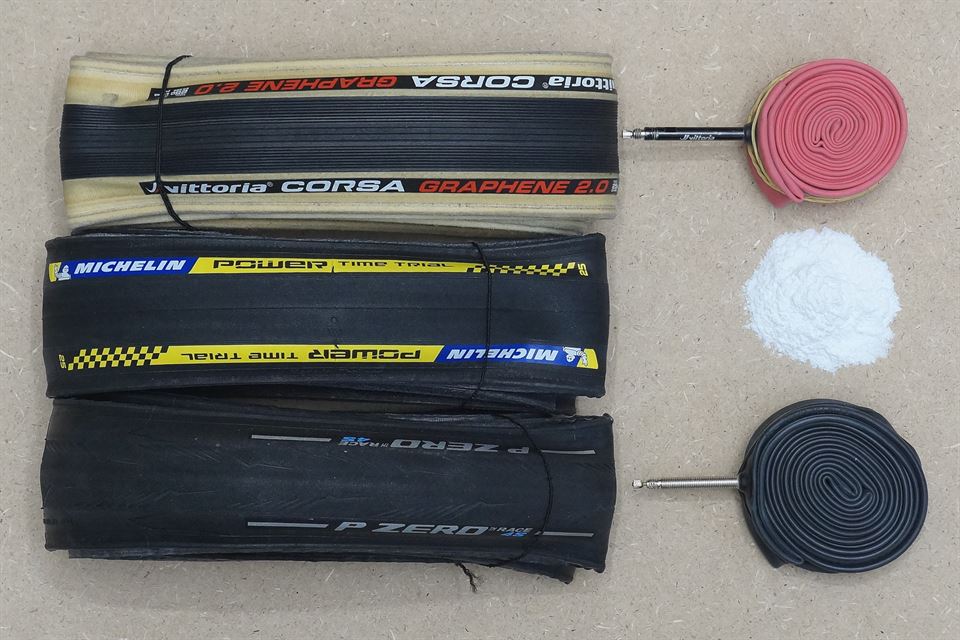Inner Tubes Talcum Powder Test: Latex and Butyl Inner Tubes
Contents

Whether it's better to install inner tubes with or without talcum powder is an ongoing discussion with no clear conclusion. We've done some (internal) tests with and without talcum powder in the past but couldn't draw a conclusion either. That was mainly because we only tested with a single tire and tube, and our results came in within the margin of error of the tests.
This time we will do a more thorough test with 3 tires and 2 different inner tubes (latex and butyl). All combinations have been tested with and without talcum powder which provides us with 6 data points, and that should be enough to draw a definitive conclusion even if those results fall within the margin of error of the tests.
We've tested the Michelin Power Time Trial, Vittoria Corsa G+ 2.0, and the Pirelli P Zero Race 4S with both a latex and a butyl tube and with and without talcum powder. To keep everything easy to understand for newcomers to the site, the main result of this test is the average of all 6 data points, and it will answer the talc or no talc question.
Pro Members can open the individual tire and inner tube data and dig into the results further. We found only subtle differences between the tires and tubes that, given the test's margin of error, don't change the outcome.
Test Set up and Conditions
We performed all tests on the same day to get the data as accurate as possible. All tests are performed using our standard test protocol. All data used for this test is 100% comparable to all other data on this website.
We used 3 different tube-type road bike tires:
- Michelin Power Time Trial 25-622
- Vittoria Corsa G= 2.0 25-622
- Pirelli P Zero Race 4S 25-622
Test Conditions
- Speed of 29 km/h / 18 mph
- Total wheel load of 42.5 kg / 94 lbs
- 700 x 17C wheel
- Temperature between 21.5-22.5 °C / 71-72 °F
- Diamond plate drum surface
- 77 cm drum diameter
Test Results - Average Results of All Tests
| Average Results of all Tests | RR 60 psi 4.1 bars |
RR 80 psi 5.5 bars |
RR 100 psi 6.9 bars |
|---|---|---|---|
| Watts | Watts | Watts | |
| Inner tubes without talcum powder | 15.3 | 13.0 | 11.6 |
| Inner tubes with talcum powder | 15.3 | 13.1 | 11.7 |
As you can see from the results above, installing inner tubes with or without talcum powder doesn't matter when it comes down to rolling resistance. We see a tiny advantage for not using talcum powder, but the 0.1 watts difference we measured can be the result of the margin of error of the tests.
These results align with the previous (internal) tests we did with talcum powder. Given that we now have multiple data points that all fall within the margin of error of our test, we're confident enough to say that using talcum powder does not result in a lower rolling resistance.
Test Results - Individual Tire Rolling Resistance Data (Pro Members)
The next section is only accessible by our highly valued Pro Members. This section includes all test data of the individual tires with latex and butyl inner tubes.
Conclusion
Our main conclusion is that using talcum powder on inner tubes does not reduce rolling resistance. Although all our test results come in within the margin of error, analyzing the test results indicates talcum powder results in a tiny increase in rolling resistance.
Another reason people use talcum powder is because it prevents the inner tube from sticking/fusing with the tire after prolonged use (probably multiple years). This can present a problem when you have a puncture and need a roadside repair, as it makes it harder to remove the inner tube.
Although this sticking/fusing can be a problem in some cases, we actually believe this is the 'holy grail' when it comes to rolling resistance. Any movement between the tire and the inner tube means energy is lost in heat, resulting in a higher rolling resistance.
Only use talcum powder when you do not want the tire and inner tube to stick together, as we really can't find any advantage other than that. Depending on the talcum powder, there might also be a health risk, given that some talcum powder might contain tiny amounts of asbestos.
